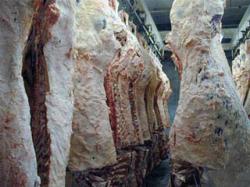Carcass Irradiation May Be Important Processing Aid In Enhancing Beef Safety
October 2, 2009 | 1 min to read

Washington, DC — Low-dose electron beam carcass irradiation can be an important processing aid to enhance beef safety, American Meat Institute (AMI) Foundation President Randy Huffman, Ph.D., told a U.S. Department of Agriculture (USDA) public meeting to solicit opinion on an AMI petition to allow the technology in beef plants.
Electron-beam irradiation uses electricity (not radioactive isotopes) to destroy bacteria. AMI’s petition seeks approval for use of the technology on the carcass surface only. The energy would not penetrate beyond one-fourth of an inch.
Huffman told USDA officials that the data clearly show that it could be remarkably effective in destroying bacteria on the carcass surface, and added that in no case has Food Safety Inspection Service (FSIS) ever required the labeling of the ingredient merely because of its antimicrobial properties at time of treatment. He stressed that the petition demonstrates the process has no significant effect on the smell, taste, appearance, shelf life or nutritional properties of the carcass or products derived from there. “We submit it would be misleading to mandate the labeling of the process or any beef derived from the carcass since those products would evidence no characteristics of irradiated products,” he told the public meeting.
“AMI agrees with the position of the Food Safety and Inspection Service (FSIS) that low dose, low-penetration electron beam (e-beam) applied to the surface of chilled beef carcasses.”
To read the rest of this story please go to: American Meat Institute
